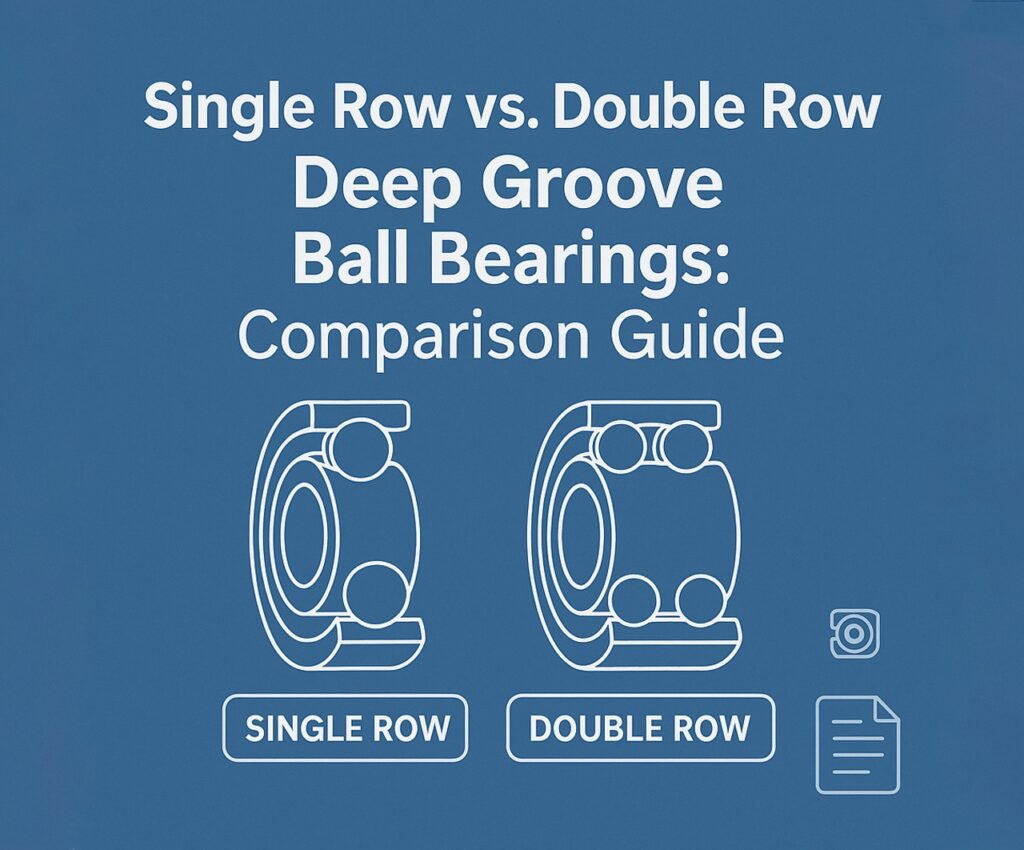When selecting the right bearing for your machinery, understanding the core differences between single row deep groove bearing and double row deep groove ball bearings types is critical. The performance, durability, and efficiency of your equipment heavily depend on this choice. If you’re working with a deep groove ball bearing supplier, you’ll notice that the options vary significantly in structure and application. Whether you’re in heavy industry, automotive, or electronics, knowing which type suits your needs can save you time, money, and headaches down the road. Know More
What is a Deep Groove Ball Bearing?
Before diving into the differences, let’s clarify what a deep groove ball bearing is. It’s one of the most commonly used bearing types across industries. These bearings have raceway grooves that closely match the radius of the balls, allowing them to handle both radial and axial loads effectively.
Because of their simple design and versatility, many businesses rely on a deep groove ball bearing supplier for everything from small electric motors to large conveyor systems.
Design: Single Row vs. Double Row
Single row deep groove bearings have one set of balls and one raceway per ring. This makes them compact and suitable for high-speed applications with moderate load capacity. Their construction is straightforward, leading to lower manufacturing costs.
In contrast, deep groove double row ball bearings include two rows of balls, effectively doubling the bearing’s load-handling capacity. Their design is slightly more complex but allows for higher rigidity and better support for heavier loads without significantly increasing the bearing’s external dimensions.
Load Capacity and Performance
Single row deep groove bearings are optimal for radial loads and can manage limited axial loads in both directions. Their performance in high-speed environments is superior due to lower friction and lighter weight.
Deep groove double row ball bearings, meanwhile, are designed to carry heavier radial and axial loads. They are ideal in conditions where shaft support is critical, and space constraints limit the use of larger bearings.
Applications and Suitability
Choosing the right type largely depends on the application:
- Single row deep groove bearings are widely used in:
- Electric motors
- Household appliances
- Power tools
- Precision instruments
- Deep groove double row ball bearings are favored in:
- Industrial gearboxes
- Agricultural machinery
- Automotive transmissions
- Conveyor systems
Understanding your equipment’s load profile and operating conditions will guide your choice. A trusted deep groove ball bearing supplier can assist in assessing these requirements.
Space Efficiency
When space is limited, deep groove double row ball bearings provide an advantage by offering more load capacity in a compact form. Instead of using two single row bearings, you can use one double row bearing and reduce installation time and space usage.
However, if axial load is minimal and space isn’t a constraint, single row deep groove bearings are more cost-effective and easier to maintain.
Friction and Heat Generation
Because single row deep groove bearings have fewer contact points, they generate less friction. This makes them more suitable for high-speed applications where minimizing heat is crucial.
Deep groove double row ball bearings, having more balls in contact, tend to generate more friction and heat. While this doesn’t usually pose a problem in moderate-speed applications, it’s a critical factor for high-speed machinery.
Maintenance and Longevity
Single row bearings are simpler and easier to inspect and replace. Their reduced complexity means fewer points of potential failure.
On the other hand, deep groove double row ball bearings can offer longer service life when properly maintained because of their ability to distribute loads more evenly. However, their failure can be harder to diagnose without specialized tools due to their more complex structure.
Cost Considerations
If budget is a major factor, single row deep groove bearings are generally less expensive. They’re more common and cheaper to produce. When working with a deep groove ball bearing supplier, this makes them a go-to option for cost-sensitive projects.
Double row bearings, while pricier, offer better performance under demanding loads. The upfront investment pays off in durability and reduced downtime in the long run.
Noise and Vibration
Noise levels can be critical, especially in electric motors or medical equipment. Single row deep groove bearings operate with minimal noise and vibration, especially when precision-manufactured.
Deep groove double row ball bearings, due to their heavier structure, may produce slightly more noise. However, high-quality bearings with tight tolerances can reduce this drawback.
Availability and Customization
Most deep groove ball bearing supplier inventories are rich in single row deep groove bearings, given their ubiquity. They come in a wide range of sizes and materials.
Double row bearings might have a more limited standard range but are often available on request or with specific customizations. Applications requiring tailored load-handling capabilities might benefit from consulting directly with the supplier for a custom solution.
Material Choices and Coatings
Both types come in materials like stainless steel, chrome steel, and ceramic. Coatings such as PTFE or zinc can enhance corrosion resistance. The choice of material often depends more on the environment than on the bearing type itself.
That said, deep groove double row ball bearings might be built with more robust materials by default, anticipating their use in more demanding environments.
Sealing Options
Sealing is essential for protecting the bearing from contaminants and retaining lubrication.
- Single row bearings often come with rubber or metal seals, or open types for easy lubrication access.
- Double row bearings are typically sealed for life, especially in industrial applications, to prevent ingress and ensure longevity.
Consult your deep groove ball bearing supplier to match the seal type with your environmental and maintenance needs.
Making the Final Choice
Here are quick pointers to help you decide:
- Choose single row deep groove bearings if:
- Your application is high-speed and low-load
- Budget and simplicity matter
- Maintenance access is frequent
- Noise and vibration need to be minimized
- Opt for deep groove double row ball bearings if:
- Load capacity is critical
- Space is limited but demands are high
- Extended bearing life is a priority
- You require compactness with performance
Final Thoughts
Choosing between single row deep groove bearing and deep groove double row ball bearing comes down to a balance of performance, cost, and application-specific requirements. By partnering with a reputable deep groove ball bearing supplier, you gain access not just to products, but to insights that can help you make the right technical decision.
Always assess your operational load, environmental factors, and space limitations before selecting a bearing. In the long term, this foresight saves money, reduces downtime, and ensures optimal machine performance.
If you’re unsure, ask your deep groove ball bearing supplier for data sheets, comparison charts, and engineering support. A good supplier understands the trade-offs and can recommend the most efficient, cost-effective solution.
In today’s competitive manufacturing and industrial landscape, choosing the right bearing isn’t just a technical decision—it’s a strategic one.

